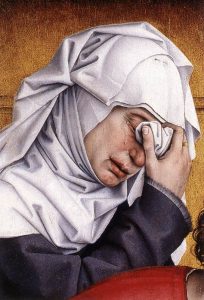Rogier van der Weyden’s Deposition
Little as we know about Jan van Eyck, we know even less about the life of Rogier van der Weyden (c. 1400-1464). Not a single existing work of art bears his name. He may have studied under the Master of Flémalle, but the relationship is not altogether clear. First establishing himself in 1432 as an independent master in Tournai, at the peak of his career, Rogier maintained a large workshop in Brussels, where he was the official city painter, attracting apprentices and shop assistants from as far away as Italy. To establish the stylistic characteristics of Rogier’s art, scholars have turned to the Deposition, an altarpiece commissioned by the Louvain crossbowmen’s guild (crossbows can be seen in the tracery painted in the upper corners) sometime before 1443, the date of the earliest known copy of it by another artist.


The Deposition was a popular theme in the fifteenth century because of its potential for dramatic, personally engaging portrayal. Rogier sets the act of removing Jesus’ body from the cross on the shallow stage of a gilt wooden box, just like the case of a carved and painted altarpiece. The ten solid, three-dimensional figures, however, are not simulations of polychromed wood carving, but near life-size renderings of actual human figures who seem to press forward into the viewer’s space, allowing them no escape from the forceful expressions of heartrending grief. Jesus’ friends seem palpably real, with their portraitlike faces and scrupulously described contemporary dress, as they tenderly and sorrowfully remove his body from the cross for burial. Jesus’ corpse dominates the center of the composition, drooping in a languid curve, framed by jarringly thin, angular arms. His pose is echoed by the rhyming form of the swooning Virgin. It is as if mother and son share in the redemptive passion of his death on the cross, encouraging viewers to identify with them both, or join their assembled companions in mourning their fate.
Although united by their sorrow, the mourning figures react in personal ways, from the intensity of Mary Magdalen at far right, wringing her hands in anguish, to John the Evangelist’s blank stare at the left, lost in grief as he reaches to support the collapsing Virgin. The anguish of the woman behind him, mopping her tear-soaked eyes with the edge of her veil, is almost unbearably poignant.
Rogier’s choice of color and pattern balances and enhances his composition. The complexity of the gold brocade worn by Joseph of Arimathea, who offered his new tomb for the burial, and the contorted pose and vivid dress of Mary Magdalene increase the visual impact of the right side of the panel to counter the pictorial weight of the larger number of figures at the left. The palette contrasts subtle, slightly muted colors with brilliant expanses of blue and red, while white accents focus the viewers’ attention on the main subjects. The whites of the winding cloth and the tunic of the youth on the ladder set off Jesus’ pale body, as the white turban and shawl emphasize the ashen face of Mary.[1]

- Marilyn Stokstad, Art History, vol. 2, 4th ed, (Upper Saddle River, NJ: Prentice Hall: 2011), 578-579. ↵

